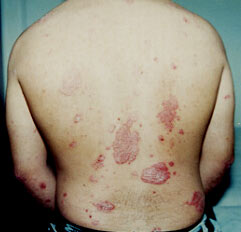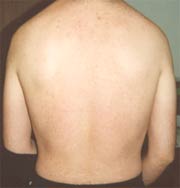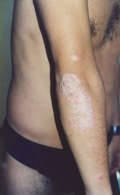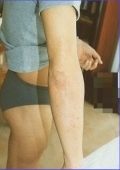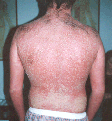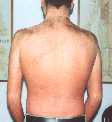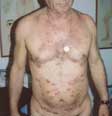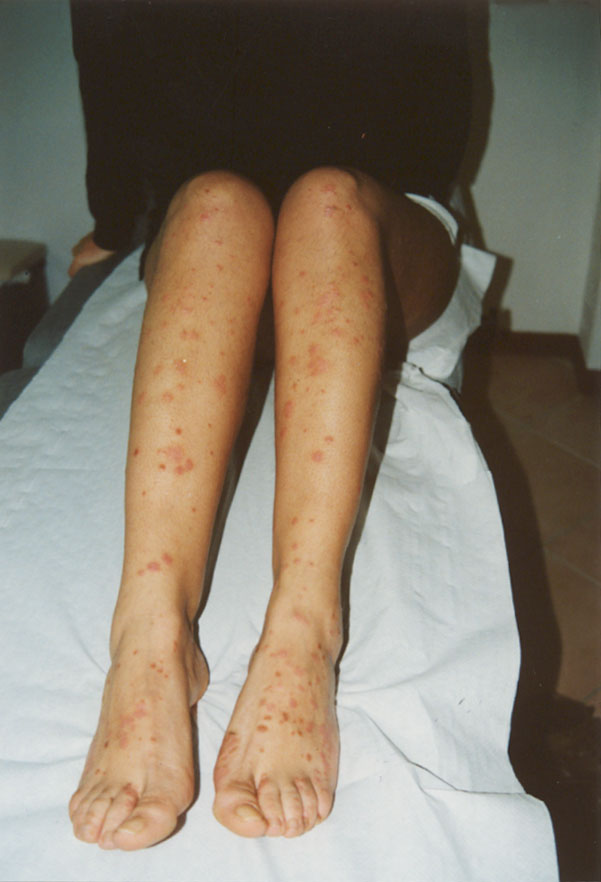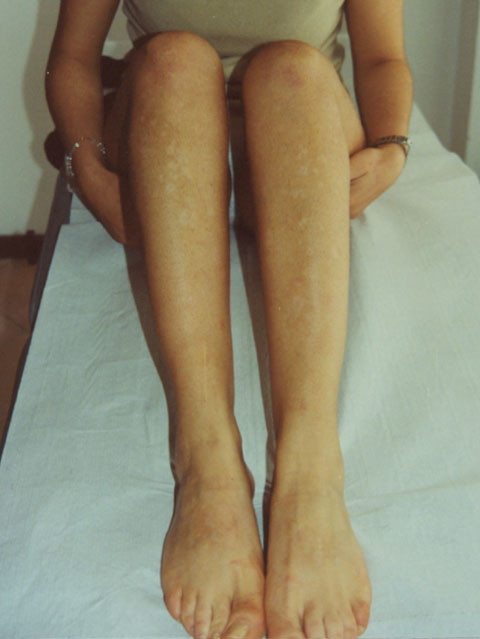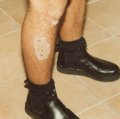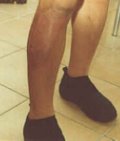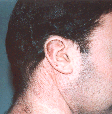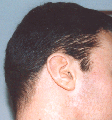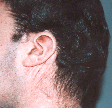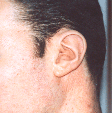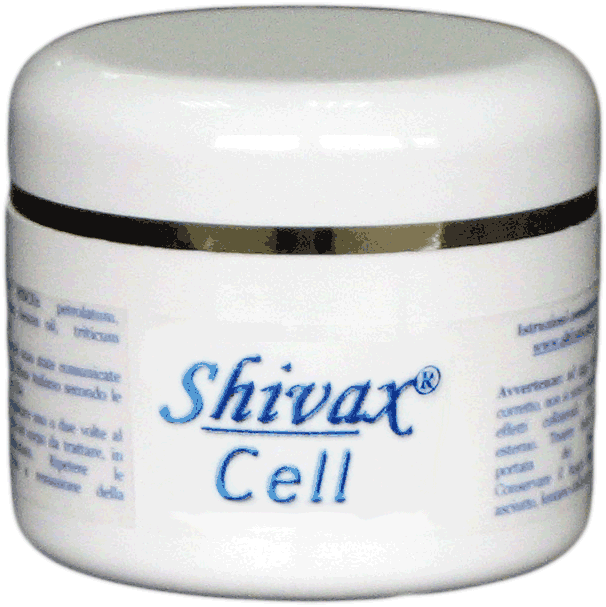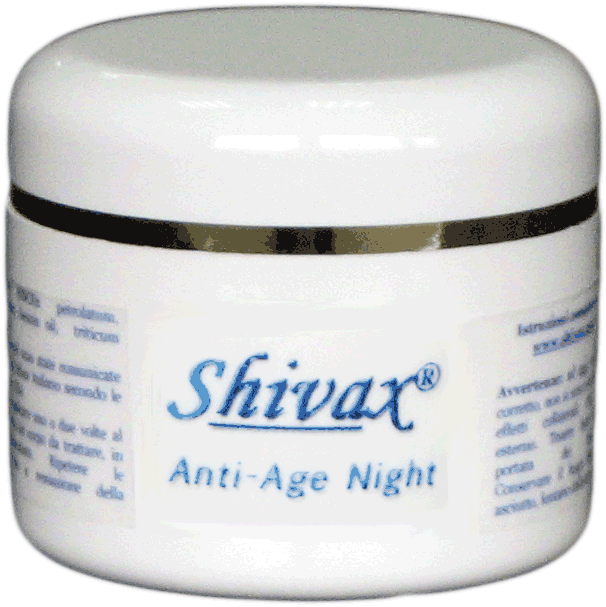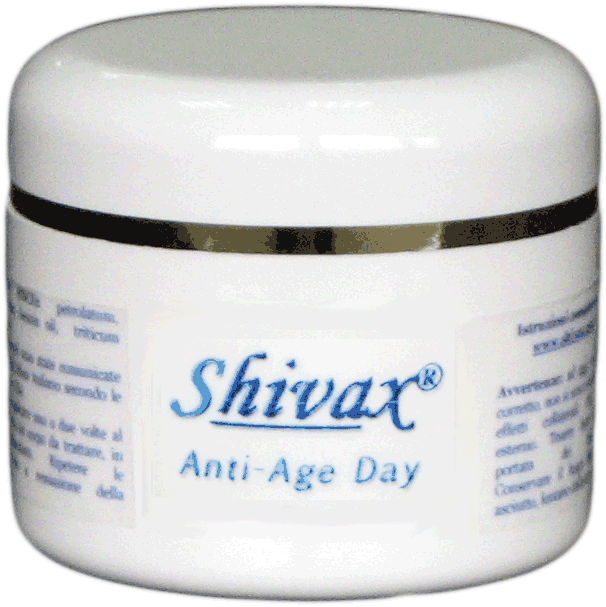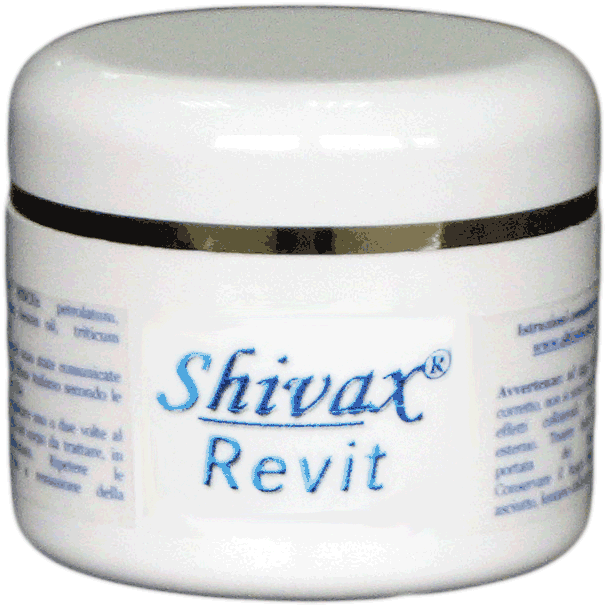|
|
L'Artritis Psoriasica
y
l'Artritis
Reumatoide son dos patologias
similares. Una fondamental
diferencia entre las dos es que en el caso de la artritis psoriasicas
estan, en el individuo, manifestaciones cutaneas de psoriasis
tambien.
En todo los casos estas dos patologias tienen una caracteristica
hereditaria. O sea està escrito en el DNA (codigo genetico
). La artritis, entonces, se manifestara en el caso que un dia
el nivel de toxinas presente al interior del organismo, sea
muy alto.
En efecto eses artritis tienen, como muchas otras patologias,
una natura Poligènicas, esto significa que la susceptibilidad
a esta enfermedad està escrito no sobre solo un gene
pero sobre màs genes. Entonces, en una misma familia
encuentreremos con mucha probabilidad otras individuos que podran
ser afectados da el diabetes del adulto, psoriasis, dermatite
seborroica, hipertension, etc.
La enfermedad se manifestara solo cuando cuando ese individuo
estarà en condicion genèrica de estrès.
Esto significa que las actuales toxinas en ese sujeto son verdadaderamente
muchas.
Un pequeño
presupuesto.....
En un coche
hay un cuadro que tiene muchas espìas luminosas que se encenden
para segnalar que algo no funciona en el coche mismo. En la "màquina
hombre" estas espìas son representadas de los sintomas,
los màs varios.
Las lesiones
articulares de la artritis psoriasica y de la artritis reumatoide,
en veridad son dos espias, que nacen para señalarnos que el nivel
de toxinas esta a niveles preocupantes.
Pero, ¿ De dònde vienen
estas toxinas?
 |
A
Partir de una alimentacion no correcta y poco sana. |
 |
De los
liquidos con los cuales nos apagamos la sed. |
 |
Del aire
que penetra en nuestros pulmones. |
 |
De los
pensiamentos que abruman nuestra mente. |
Da los estudios de numerosos investigadores internacional (ver
bibliografia) y mismo da mis
esperiencias, resulta evidente
cuanto la Artritis Psoriasica y
Artritis Reumatoide, juntas a otras enfermedades
con componente psicosomatica, estan en relacion con la infecion
cronica de CANDIDA ALBICANS.
La Candida Albicans es un hongo que està en nuestro organismo
desde el nacimiento. En efecto, cuando el niño cruza
el canal de salida del resto de su madre, se afecta, puesto
que este hongo està normalmente en gran cantidad en el
lìquido vaginal de las mujeras embarazadas. A partir
de este momento la Candida va a colonizar la mucosidad del intestino
tenue, su hogar verdadero, però hasta cuando el nùmero
de las actuales colonias no serà elevado, no representerà
por el individuo ninguna molestia y no provocarà algùn
daño. Pero, si el sistema inmunitario serà
presionado,
por diferentes razones, y el individuo se truverà en
condiciòn de èstres, las colonias aumentaràn
de nùmero.
A este punto se podrìa
haber otras manifestaciones de esta infecciòn, a travès
algunas "segundas casas" de la Candida, como la infecciòn
vaginal o ardores al nivel del penis como el mughetto, el hongo
de la piel, el pie del atleta, etc...
Los màs silenciosos, pero, son los efectos de las 79
toxinas
producidas por la Candida y lo demàs dirigidas
hacia el sistema nervioso central y el sistema inmunitario secundario
(es decir lo intestinal) y el principal.
En efecto la infecciòn de la Candida està en todos
los individuos que sufren de patologias con elemento psicosomàtico.
Se recuerden que las
toxinas producidas por ella modifican el pensamiento. ¿
Ha pasado a Usted de tener la gana de comer Pan,
Pasta, Pizza, Patatas
(llamade por el DOCT.
ENZO DI MAIO "Le cuatro P"),
Dulces
o Azùcar? Si es asì, no es su
organismo que pide
el azùcar porquè està desprovisto, pero
es la
Candida que lo pide. Ella se nutre solamente de carboidrates (azùcares) simples
y cuando necesita de alimentarse, envia algunas toxinas al cerebro
para que el individuo asume una cantidad suficiente.
Aproximadamente,
despuès de quinze minutos, su comida serà terminada
y entonces enviarà otras toxinas al cerebro para sugerir
que ya no tiene màs hambre, y para que no se introducen
otros alimentos. Ese sujeto percibirà una sensaciòn
desagradable de hinchazòn abdominal ( debido al metabolismo
del hungo) y pensarà "...Pero ¿Què
he comido? Comì solo un poquito de pan o un dulcito..."
La lista de las patologias en las cuales
al interno hay una grande compartecipaciòn de la Candida
podrìa ser muy larga pero es muy importante recordar
algunas de esas.
Entre las menores:
La GASTRITIS, COLITIS
(sea con el estipsi que con la
diarrea), varios disturba
digestives,
DEPRESIÓN (Sìndrome de la Fatiga Crònica),
ANSIEDAD, OBESIDAD, ANOREXIA, INSOMNIO, DISMENORREA
e
SINDROME
PREMESTRUALE, VAGINITI o CISTITI recurrentes, BALANOPOSTITIS
(inflamacion del Penis), HERPES
en dimensiones varias, CONDILOMI
y MICROCONDILOMI di HPV (Virus Humano de
Papilloma),
DOLOR DE CABEZA, INTOLERANCIAS, de la
DERMATITIS
SEBORROICA, etc..
.Entre
los màs importantes:
PSORIASIS, ARTRITIS RHEUMATOID,
ARTRITIS PSORIASICA, VITILIGO, LUPUS, ENFERMEDAD de CR, DIABETIS
del adulto,
DEPRESIONES GRAVES, ULCER
GASTRO-DUODENAL, ASMA
alérgico y no, HIPERTENSIÓN ARTERIALES,
etc...
Si estas enfermedades
parecen muchas a ustedes, piensen que segùn la estadìsticas
norteamericana, la infecciòn crònica del hongo,
golpea entre el 70% y el 80% de la poblaciòn del mundo (ver
bibliografia). En los ùltimos 15-20 años todo
el mundo ha podido observar un incremento notable de muchas
patologìas supuestas psicosomàticas y màs
en general de infecciones por la Candida.Esto es debido a muchos
factores, entre los cuales: indistinto uso de antibiòticos,
remedios por el sistema nervioso, (antidepresivos,
tranquilizantes,
pildoras para dormir,), cortisòn, anticonceptivos, remedios
por las ulceras (cimetidina, etc.), valerse, en campo
alimenticio,
de conservantes y colorantes y tambièn en el utilizar
y exagerar en los productos originantes del granos.
A nivel diagnòstico,
pueden utilizarse nùmerosos tratamientos como la bùsqueda
directa de la Candida en las heces, en la orina u en la secretiòn
vaginal o del penis, resulta ùtile todavia utilizar,
sea por las estadìsticas que por el estudio de la sintomatologia
relacionada, unos cuestionarios estudiados por estos
motivos.
Una vez que se individua la presencia
de la infecciòn crònica por la Candida (Chronic
Candidiasis Syndrome o Candida Related Complex en inglès)
se tiene que establecer la terapia màs correcta considerando
primero el individuo enteramente, y luego la patologia por la
cual està afectado.
Entonces sera posible efectuar un discurso sea
alimentar y sea
uno
no
alimentar:
Esquematicamiente el encuentro
para l' ARTRITIS PSORIASICA y para
l'ARTRITIS REUMATOIDE:
 ALIMENTAR
en base a la
costitucion individual , a las eventuales intolerancias
alimenticias y a la infecciòn crònica por la Candida.
Entonces con una alimentacion para establecer el equilibrio
perdido. Despues viene singularmente
elaborada por cada individuo,
correcto para aquel momiento
de la vida.
ALIMENTAR
en base a la
costitucion individual , a las eventuales intolerancias
alimenticias y a la infecciòn crònica por la Candida.
Entonces con una alimentacion para establecer el equilibrio
perdido. Despues viene singularmente
elaborada por cada individuo,
correcto para aquel momiento
de la vida.
 NO
ALIMENTAR para ayudar
el restablecimiento de una buena funcionalidad del sistema
inmunitario, sin utilizo de farmacos.
NO
ALIMENTAR para ayudar
el restablecimiento de una buena funcionalidad del sistema
inmunitario, sin utilizo de farmacos.
Para rebuscar, en modo
simple y natural el propio equilibrio perdido, se podrà efectuar el
"Protocolo Personal"
(veer
a la
pagina
www.psoriasi.org/psoriasis.sp/protocoloterapeutico.htm)


|
|
100% NATURAL |
|
|
 |
 |
 |
 |
|
Shivax® Plus |
Shivax® FT |
Shivax® U |
Shivax® G |
|
 |
 |
 |
|
As
 são produtos Inovadores
são produtos Inovadores
Função e são Sem
Cortisona |
|
Chamanós
Brasil (São
Paulo) +55-1139570424
|
|
 |

| |
100 % NATURAL |
|
|
|
|
|
|
|
|
Shivax® Cell
Tratamento de
Celulite e
Gordura Localize
Homens e Mulheres |
Shivax® Anti-Age Night
Tratamento Noite
de Rugas Revigorantes
Anti Idade |
Shivax® Anti-Age Day
Tratamento Dia
de Rugas Revigorantes
Anti Idade |
Shivax® Revit
Tratamento Específico
dos olhos e boca Revigorantes
Anti Idade |
|
As
 são produtos Inovadores
são produtos Inovadores
Função e são Sem
Cortisona |
|
|
|
|
Chamanós
Brasil (São
Paulo) +55-1139570424
|
| |
|
|

ITALIA
SEDE
ITALIANA
Via Cassia km
36,400
Zona Industriale Settevene
01036 Nepi (VT) Italia
+39.0761.527705
+39.0761.527306
Segunda-feira Sexta-feira
09.00 - 18.00
( h o r
a l o c a l ) |
|
|
Su Asistente
Pessoal
|
info@shivax.com

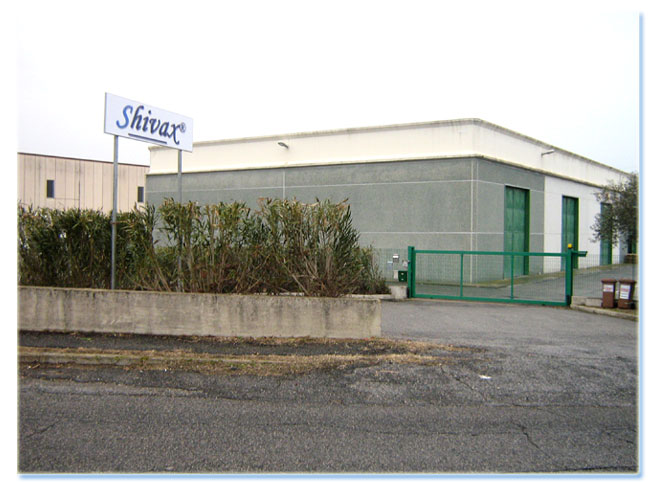
 |
|
|
 |
|
|
BIBLIOGRAFIA
Iwata, K.; Yamamoto, Y. Glycoprotein Toxins Produced by Candida albicans.
Proceedings of the Fourth International Conference on the Mycoses, PAHO Scientific
Publication #356, June 1977.
Quiralte, J.; Blanco, C.; Esparaza, R.; Castillo, R. Carrillo, T. Nasal Candidiasis
in an Immunocompetent Patient. Allergologia et Immunopathologia. 21(6):227-8, 1993
Nov.-Dec.
Magnavita, N. Mucocutaneous candidiasis in exposure to biological agents: a clinical
case. Medicina del Lavoro. 84(3):243-8, 1993 May-Jun. (in Italiano)
Gutierrez, J.; Maroto, C.; Piedrola, G.; Martin, E.; Perez, JA. Circulating Candida
antigens and antibodies: useful markers of candidemia. Journal of Clinical
Microbiology. 31(9):2550-2, 1993 Sep.
Walsh, TJ.; Lee, JW.; Sien, T.; Schaufele, R.; Bacher, J.; Switchenko, AC.;
Goodman, TC.; Pizzo, PA. Serum D-arabinitol measured by automated quantitative enzymatic assay
for detection and therapeutic monitoring of experimental disseminated candidiasis:
correlation with tissue concentrations of Candida albicans. Journal of Medical &
Veterinary Mycology. 32(3):205-15, 1994.
Switchenko, AC. Miyada, CG. Goodman, TC. Walsh, TJ. Wong, B. Becker, MJ Ullman,
EF. An
automated enzymatic method for measurement of D-arabinitol, a metabolite of pathogenic
Candida species. Journal of Clinical Microbiology. 32(1):92-7, 1994 Jan.
Hussain, G.; Galahuddin, N.; Ahmad, I.; Galahuddin, I.; Jooma, R. Rhinocerebral
invasive mycosis: occurrence in immunocompetent individuals. European Journal of
Radiology. 20(2):151-5, 1995 Jul.
Cater, RE., 2nd Chronic candidiasis as a possible etiological factor in the chronic
fatigue syndrome. Medical Hypotheses. 44(0):507-15 Jun. 1995
Crook, WG. The Yeast Connection Professional Books, Jackson Tennessee
Crook, WG. The Yeast Connection and the Woman. Professional Books, Jackson
Tennessee
Di Maio E,
M.D Ayurveda contro i disturbi della donna. Silhouette,
3D Editoriale, Anno 5°, Numero 4, Aprile 1998, Milano .
Di Maio E,
M.D. Reiki, Ayurveda, alimentazione ed altro.
Puntoluce, Anno 11°, Numero 41, Primavera 1998, Milano.
Di Maio E,
M.D. Come diagnosticare le infezioni da Candida albicans. Polizia
Sanitaria, DCB, Anno 12°, Numero 75, 2004, Milano
Widder, RA.; Bartz-Schmidt, KU.; Geyer, IL.; Brunner, R.; Kirchhof, B.; Donike, M.;
Ileinmann, K. Candida albicans endophthalmitis after anabolic steroid abuse (letter).
Lancet. 345(8945):330-1, 1995 Feb 4.
Ross, VE.; Baxter, DL. Widespread Candida Folliculitis in a Nontoxic Patient.
Cutis. 49(1):241-243, 1992 April.
Cater, RE. Somatization disorder and the chronic candidiasis syndrome: a possible
overlap. Medical Hypotheses. 35:126-135, 1991.
Kroker, GF. Chronic Candidiasis and Allergy. In: Brosteff J.; Challacombe
SJ.;eds. Food Allergy and Intolerance. London:Baillierre Tindall, 1989: ch. 49.
Kirkpatrick, CH.; Smith, TK. Chronic mucocutaneous candidiasis: immunologic and
antibiotic therapy. Annals of Internal Medicaine. 80: 310-320, 1974.
Dismukes, WE., Way, JS., Lee, JY., Dockery, B.K., Hain, J.D., A randomized
double-blind trial of nystatin therapy for the candidiasis hypersensitivity syndrome.
New England Journal of Medicine. 323:1717-23, 1990.
Bennett, JE. Searching for the yeast connection. New England Journal of Medicine.
323:1766-67, 1990.
Zwerling, MH., Owens, KN., Ruth, NH. Think yeast-the expanding spectrum of
candidiasis. Journal of the South Carolina Medical Association. 80:454-456, 1984.
Mangani V.,Panfili A., Candida l'epidemia silenziosa:allergia al XX secolo?
ed.Tecniche Nuove 1996.
Mangani V.,Panfili A.,La dieta ph ed.
Tecniche
Nuove 1997.
Panfili A., Medicina Ortomolecolare.ed Tecniche Nuove 1994
Truss, CO. The role of candida albicans in human illness. Journal of
Orthomolecular Psychology. 10:228-238, 1981.
Truss, CO. Tissue injury induced by candida albicans. Journal of Orthomolecular
Psychology. 7(1)
Truss, CO. Restoration of immunologic competence to candida albicans. Journal of
Orthomolecular Psychology. 9(4)
Truss, CO. Metabolic abnormalities in patients with chronic candidiasis: the
acetaldehyde hypothesis. Journal of Orthomolecular Psychology. 13(2):66-93
Bodey, G., Fainstein, V., Garcia, I., Rosenbaum, B., Wong, Y. Effect of
broad-spectrum cephalosporins on the microbial flora of recipients. The Journal of
Infectious Diseases. 148:892-897, 1983.
Giuliano, M., Barza, M., Jacobus, N., Gorbach, S. Effect of broad spectrum
antibiotics on composition of intestinal microflora of humans. Antimicrobial Agents
and Chemotherapy. 202-206, 1987.
Gracey, M., Burke, V., Thomas, J. Stone, D. Effect of microorganisms isolated from
the upper gut of malnourished children on intestinal sugar absorption in vivo The
American Journal of Clinical Nutrition. 28:841-845, 1975.
Eras, P., Goldstein, M., Sherlock, P. Candida infection of the gastrointestinal
tract. Medicine 51(5):367-379, 1972.
Trowbridge, J.P., Walker, M. The Yeast Syndrome. Bantam Books. New York, 1986.
Hotopf, Matthew. Seasonal affective disorder, environmental hypersensitivity and
somatisation. British Journal of Psychiatry. 164: 246-248, Feb. 1994.
Keith, Sehnert W. Candida-related complex (CRC), a complicating factor in treatment
and diagnostic screening for alcoholics: A pilot study of 213 patients. International
Journal of Biosocial and Medical Research. 13(1):67-76, 1991.
Rogers, Sherry A. Healing from the inside out: The leaky gut syndrome.
Let's
Live. 63(4):34-38, Apr 1995.
Neuro-Immunophysiology of the Gastrointestinal Mucosa. Annals of the New York
Academy of Sciences. 664, 1992
Shorter, RB. Kirsner, JB. Gastrointestinal Immunity for the Clinician. Grune
& Stratton, Inc., Orlando, FL. 1985
Murray, F. Acidophilus fights fungal infections. Better Nutrition for
Today's Living. 56(5):54-55, May 1994
Palmer, CA. A yeast for all reasons or is candidiasis the hidden enemy? Nutrition
Today. 28(3)24-29, May 1993
Yeast can destroy friendly bacteria. USA Today: The Magazine of the AMerican Scene.
122(2585):6-7, Feb. 1994
Hentges, David J. Human intestinal microflora in health and disease. Academic
Press: NY, 1983
Hill, MJ. Role of gut bacteria in human toxicology and pharmacology. Taylor &
Francis: Bristol, PA, 1995.
Rowland, IR. Role of the gut flora in toxicity and cancer. Academic Press:San
Diego, 1988
Brostoff, J. Challacombe, SJ. Food Allergy and Intolerance. Bailliere
Tindall: Philadelphia.
Winner, HI. Hurley, R. Symposium on Candida Infections. E & S Livingstione
LTD: London, 1966
James, J. Warin, RP. An assessment of the role of Candida albicans and food yeasts in
chronic urticaria. British Journal of Dermatology. 84:227-237, 1971
Schinfeld, JS. PMS and candidiasis: study explores possible link. The Female
Patient. 12:July 1987
Witkin, SS. Defective immune response in patients with recurrent candidiasis.
Infections in Medicine. May-June 1985
Resseger, Charles S., D.O. or Norwalk, OH. Conversations with
Giannela, RA. Broitman SA. Zamcheck, N. Influence of gastric acidity on bacterial and
parasitic enteric infections: a perspective. Annals of Internal Medicine. 78: 271,
1973
Gordon, JE. Chitkara, ID. Wyon, JB. Weanling diarrhea. American Journal of
Medical Science. 245:345, 1963
Mackowiak PA. The Normal Microbial Flora. New England Journal of Medicine.
307:83, 1982
Freter, R. Interactions between mechanisms controlling the intestinal microflora.
American Journal of Clinical Nutrition. 27:1409, 1974
Bartlett, JG. Antibiotic associated pseudomembranous colitis. Rev Infect Dis.
1:123, 1979
Freter, R. Brickner, H. Botney, M. et al. Mechanisms that control bacterial
populations in continuous flow culture models of mouse large intestinal flora.
Infectious Immunology. 39:676, 1983
Shedlofsky, S. Freter, R. Synergism between ecologic and immunologic control
mechanisms of intestinal flora. Journal of Infectious Diseases. 137:661, 1978
Renfro, L. Feder, HM Jr. Lane, TJ. Manu, P. Matthews, DA. Yeast connection among 100
patients with chronic fatigue. American Journal of Medicine. 86(2):165-8, Feb. 1989.
Schlossberg, D. Devig, PM. Travers, H. Kovalcik, PJ Mullen, JT. Bowel perforation
with candidiasis. Journal of the American Medical Association. 238(23):2520-1, Dec 5,
1977.
Schwartz, RH. Knerr, RJ. Candida esophagitis during treatemnt for adolescent acne
vulgaris. Pediatric Infectious disease. 1(5):374, Sep-Oct, 1982.
Jayagopal, S. Cervia, JS. Colitis due to Candida albicans in a patient with AIDS.
Clinical Infectios Diseases. 15(3):555, Sep. 1992.
Minoli G. Terruzzi V. Butti G. Frigerio G. Rossini A. Gastric candidiasis:an
endoscopic and histological study in 26 patients. Gastrointestinal
endoscopy.
28(2)59-61, 1982.
Tortora, G. Funke, B. Case, C. Microbiology. New York: Benjamin/Cummings
Publishing Company, 1995.
Saltarelli, Cora G. Candida albicans: The Pathogenic Fungus. Hemisphere
Publishing Company: Philadelphia, 1989.
Segal, Esther; Baum, Gerald L. Pathogenic Yeasts and Yeast Infections. CRC Press:
Ann Arbor, 1994.
Jenzer, Martin, M.D. or Rochester, NY. Conversations with.
Nelson, Robert S. Bruni, Hamilton C. Goldstein, Harvey M. Primary gastric candidiasis
in uncompromised subjects. Gastrointestinal Endoscopy. 22:2, 92-94, 1982.
Chan, Stephen, PhD, of SUNY College at Brockport, NY. Conversations with.
Discussions with patients that have been treated with antifungal and diet
therapy.
Candida e Psoriasis na Patologia Dermatologica
Skinner, RB. Jr. Rosenberg, W. Noah, PW. Psoriasis of the palms and soles is
frequently associated with oropharyngeal Candida albicans. Acta Dermatological
Venereol Supplement. 186:149-150, 1994.
M buslau, Menzel I, Holzmann H. Fungal flora of the human faeces in psoriasis and
atopic dermatitis. Mycoses. 33:2, 90-4, Feb. 1990.
Soyeur U. Kilic H. Alpan O. Anti-Candida antibody levels in psoriasis vulgaris. Cent.
Afr. Journal of Medicaine. 36: 8, 190-2, Aug. 1990.
Baker BS. Powles AV. Malkani AK. Altered call-medicated immunity to group A
haemolytic atreptococcal antigens in chronic plaque psoriasis. British Journal of
Dermatology. 125: 1, 38-42, Jul 1991.
el-Maghrabi EA. Dixon DM. Burnett JW. Characterization of Candida albicans
epidermolytic proteases and their role in yeast-cell adherance to keratinocytes. Clinical
Experimental Dermatology. 15: 3, 183-91, May 1990.
Senff H. Bothe C. Busacker J. Reinel D. Studies on the yeast flora in patients
suffering from psoriasis capillitii or seborrheic dermatitis of the scalp. Mycoses.
33:1, 29-32, Jan 1990.
Orkin VF. [The characteristics of the clinical picture of candidiasis of the skin and
mucous membranes in patients with chronic dermatosis] - Russian. Vrach Delo. 5,
78-80, May 1992.
McKay M. Vulvar dermatoses: common problems in dermatological and gynecological
practice. British Journal of Clinical Pract. Sym. Supplement. 71: 5-10, Sep
1990.
Noah PW. The role of microorganisms in psoriasis. Semin Dermatology. 9:4,
269-76, Dec 1990.
Haneke E. Fungal infections of the nail. Semin Dermatology. 10: 1, 41-53,
Mar 1991.
Rosenberg, EW. Noah PW. Skinner RB. Microorganisms and psoriasis. Journal of
the National Medical Association. 86:4, 305-10, Apr 1994.
Meinhof W. [Intestinal colonization with Candida albicans and its effect on chronic
inflammatory dermatoses]-German. Hautarzt. 46:8, 525-7, Aug 1995.
Buslau L. Hanel M. Holzmann H. The significance of yeasts in seborrheic eczemna. Hautarzt.
40(10):611-3, Oct. 1989. - German
Henseler T. [Mucocutaneous candidiasis in patients with skin diseases] - German. Mycoses.
38 Supplement 1:7-13, 1995.
Kemeny L. Ruzicka T. Dobozy A. Michel G. Role of interleukin-8 receptor in skin. International
Archives of Allergy and Immunology. 104: 4, 317-22, Aug 1994.
Squiquera L. Galimberti R. Morelli L. Plotkin L. Milicich R. Kowalckzuk A. Leoni J. Antibodies
to proteins from Pityrosporum ovale in the sera from patients with psoriasis. Clinical
Experimental Dermatology. 19: 4, 289-93, Jul 1994.
Oranje AP. Dzoljic-Danilovic G. Michel MF. Aarsen RS. van Joost, T. [Is juvenile
seborrheic dermatitis a candidiasis? Studies of a possible link with microbial
infections.] - German Tijdschrift voor Kindergeneeskunde. 55(3):87-92, Jul
1987.
Candida e Diarreia
Burke, V., Gracey, M. An experimental model of gastrointestinal candidiasis
Journal of Medical Microbiology. 13:103-110.
Gupta, T., Ehrinpreis, M. Candida-associated diarrhea in hospitalized patients.
Gastroenterology. 98:780-785, 1990.
Danna, P., Urban, C., Bellin, E., Rahal, J. Role of candida in pathogenesis of
antibiotic-associated diarrhoea in elderly inpatients. The Lancet. 337:511-514, 1991.
Bishop, R., Barnes, G. Depression of lactase acitivity in the small intestines of
infant rabbits by Candida albicans.
Kane, J., Chretien, J., Garagusi, V. Diarrhoea caused by Candida The Lancet.
335-336, 1976. (Immunocompetent).
Garagusi, VF. Chretien, JH. Diarrhoea caused by Candida.(letter) Lancet.
1(7961):697-8, Mar 27, 1976.
Letter in Lancet in response. Enweani IB. Obi CL. Jokpeyibo M. Prevalence of Candida
species in Nigerian children with diarrhoea. J.Diarrhoeal Dis Res 12(2):133-5,
Jun, 1994.
Gut flora in normal and disordered states. Chemotherapy. 5-15, 1995.
Vogel LC. Antibiotic-induced diarrhea. Orthop Nurs 14(2): 38-41, Mar-Apr,
1995.
Koffi-Akoua G. Ferly-Therizol M. Kouassi-Beugre MT. Konan A. Timite AM. Assi Adou J.
Assale G. [Cryptosporidium and candida in pediatric diarrhea in Abidjan.] Bull
Soc Pathol Exot Filiales 82(4): 451-7, , 1989.
Ngan PK. Khanh NG. Tuong CV. Quy PP. Anh DN. Thuy HT. Persistent diarrhea in
Vietnamese children: a preliminary report. Acta Paediatric Supplement. 381:
124-6, Sep, 1992.
Siregar CD. Sinuhaji AB. Sutanto AH. Spectrum of digestive tract diseases 1985-1987
at the Pediatric Gastroenterology Outpatient Clinic of Dr. Pirngadi General Hospital,
Medan. Paediatr Indones. 30(5-6): 133-8, May-Jun, 1990.
Talwar P. Chakrabarti A. Chawla A. Mehta S. Walia BN. Kumar L. Chugh KS. Fungal
diarrhoea: association of different fungi and seasonal variation in their incidence. Mycopathologia.
110(2): 101-5, May, 1990.
Omoike IU. Abiodun PO. Upper small intestinal microflora in diarrhea and malnutrition
in Nigerian children. Journal of Pediatric Gastroenterolog Nutrition 9(3):
314-21, Oct, 1989.
Inmunosupreção
Hirschel B. [AIDS and gastrointestinal tract: a summary for gastroenterologists and
surgeons] Schweiz Med Wochenschr. 120(14): 475-84, Apr 7, 1990.
Gage TP. Eagan J. Gagnier M. Diverticulitis complicated by candidal pylephlebitis.
South Med. Journal 78(10): 1265-6, Oct, 1985.
Caselli M. Trevisani L. Bighi S. Aleotti A. Balboni PG. Gaiani R. Bovolenta MR.
Stabellini G. Dead fecal yeasts and chronic diarrhea. Digestion. 41(3):
142-8, 1988.
Zhen DL. [Analysis of the causative organisms in adult acute infectious diarrhea
encountered in the past 12 years]. Chung Hua Nei Ko Tsa Chih 21(9): 540-2, Sep,
1982.
Lorenz A. Grutte FK. Schon E. Muller B. Klimmt G. [Fungal infection of the small
bowel mucosa.] Mykosen. 27(10): 506-10, Oct, 1984.
Candida e Antibioticos
[Clinical evaluation of a new oral
penem, SY5555, in the pediatric field.] Japanese
Journal of Antibiotics. 41-8, Jan, 1995.
Elmer GW. Surawicz CM. McFarland LV. Biotherapeutic agents: A neglected modality for
the treatment and prevention of selected intestinal and vaginal infections. Journal
of the American Medical Association. 275(11): 870-6, Mar 20, 1996.
|
|
|

|
|
Enviar
a info@shivax.com
un mensajem email com todas as perguntas o comentàrios sobre este
Sito Web
A
l l R i g h t s R e s e
r v e d - T o d o s o s
D e r e i t o s e s t a m
R e s e r v a d o s
|
|


